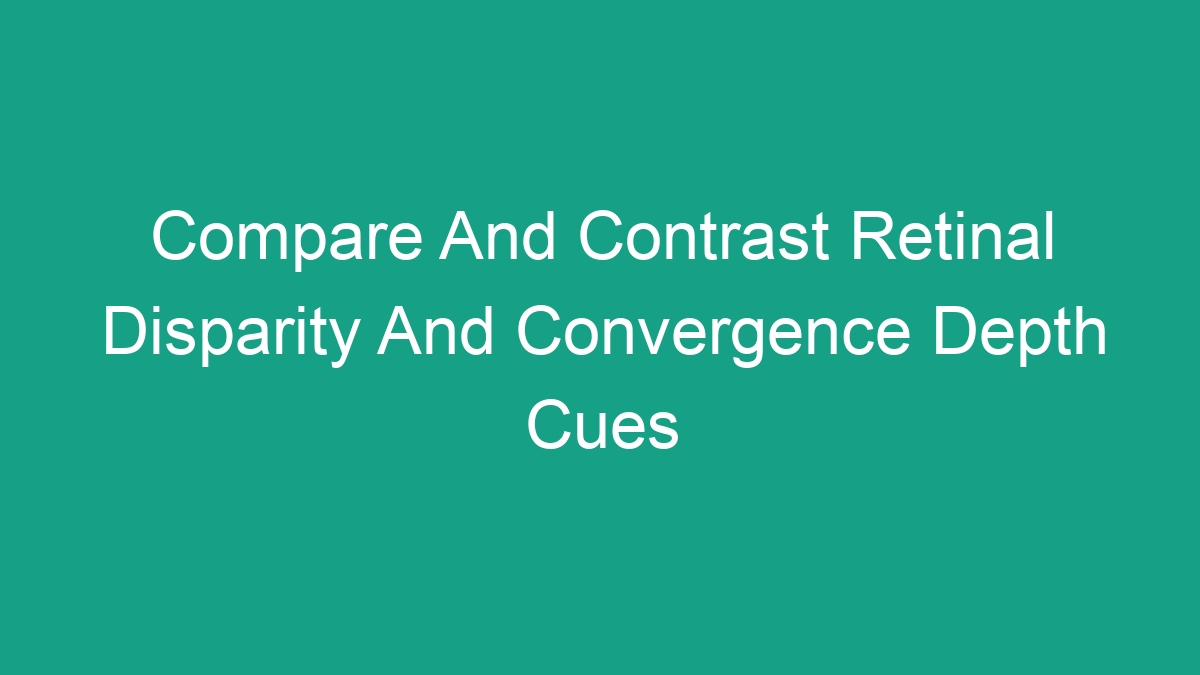
Depth perception is the visual ability that allows humans to perceive the world in three dimensions and to judge distances. This crucial skill enables us to navigate the environment, interact with objects and people, and carry out numerous everyday tasks. The human visual system utilizes various depth cues to perceive depth and distance, and two of the most important cues are retinal disparity and convergence. In this article, we will compare and contrast these two depth cues, exploring how they function, their differences, and their impact on visual perception.
Retinal Disparity Depth Cue
Retinal disparity is a crucial depth cue that relies on the positional differences of objects on the retinas of the left and right eyes. Because the eyes are spaced apart, each eye receives a slightly different image of the same object. This difference in perspective allows the brain to interpret and calculate the distance of the object. The greater the difference between the images on the retinas, the closer the object is perceived to be.
This phenomenon can be easily observed by the use of a simple experiment. By holding a finger in front of your face and closing one eye, then switching to the other eye, you can observe your finger seemingly shift position. This apparent movement is due to the difference in perspective presented to each eye, creating the perception of depth.
The brain processes these differences and combines the two images to create a single, unified three-dimensional image. This process, known as stereopsis, allows us to perceive depth and distance accurately. In essence, retinal disparity relies on the geometric differences between the two retinal images to inform the brain about an object’s depth.
Convergence Depth Cue
In contrast, convergence is another crucial depth cue that relies on the position of the eyes and the effort required to focus on an object. This depth cue comes into play when the eyes move inwards or converge to focus on an object at close range. The closer the object is, the more the eyes need to converge to focus on it.
When an object is far away, the eyes are almost parallel, but as the object moves closer, the eyes need to turn inward, causing the eye muscles to contract. The strain on the eye muscles and the angle at which the eyes converge provide the brain with information about the distance and depth of the object.
Furthermore, the brain uses the amount of convergence necessary to focus on an object as an indication of the object’s distance, allowing us to perceive depth accurately. This cue is particularly important for near-distance depth perception and is crucial for activities such as reading and using handheld devices.
Comparing Retinal Disparity and Convergence
While both retinal disparity and convergence are essential depth cues that contribute to our perception of the world in three dimensions, there are several key differences between the two cues.
One of the main differences lies in the underlying mechanism. Retinal disparity relies on the geometric differences between the images formed on the retinas, while convergence depends on the inward movement of the eyes and the effort required to focus on an object. In essence, retinal disparity is based on the differences between the two retinal images, whereas convergence is based on the muscular effort and angle of the eyes.
Another key difference is the range at which each cue is effective. Retinal disparity is most effective for objects at a moderate to far distance, while convergence is particularly important for near-distance depth perception. So, while retinal disparity is crucial for perceiving depth in the distance, convergence is crucial for perceiving depth up close.
Furthermore, retinal disparity is closely linked to the phenomenon of stereopsis, which allows for the integration of the two retinal images into a single, three-dimensional perception. Convergence, on the other hand, does not rely on the integration of two different images but rather on the muscular effort of the eyes.
Impact on Visual Perception
Both retinal disparity and convergence play essential roles in our visual perception of depth and distance. Without these depth cues, our ability to accurately judge distances and perceive the world in three dimensions would be severely compromised. Understanding the impact of these cues on visual perception can provide insights into how our visual system processes and interprets spatial information.
The importance of retinal disparity and convergence becomes evident when considering scenarios such as driving, where accurate depth perception is crucial for judging the distance and speed of approaching vehicles and objects. Additionally, in activities such as sports and navigating crowded environments, the ability to accurately perceive the distance and position of objects is essential for performing tasks safely and effectively.
Conclusion
In conclusion, retinal disparity and convergence are two fundamental depth cues that play crucial roles in our perception of depth and distance. While retinal disparity relies on the geometric differences between the images formed on the retinas, convergence depends on the inward movement of the eyes and the effort required to focus on an object. Each of these cues is essential for perceiving depth at different distances and contributes to our ability to navigate and interact with the world in three dimensions.
Understanding the mechanisms and impact of these depth cues provides valuable insights into the remarkable abilities of the human visual system and its capacity to interpret spatial information. By comparing and contrasting retinal disparity and convergence, we gain a deeper understanding of how our visual system processes depth perception, laying the foundation for further research and exploration in the field of visual perception.



